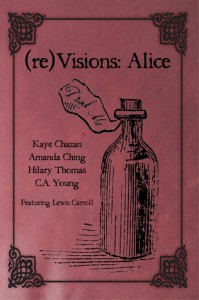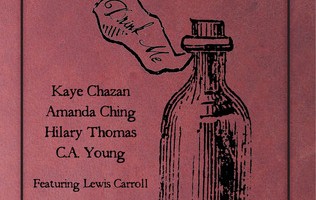 Lewis Carroll’s classic tale, Alice in Wonderland, has been a mainstay of Western popular culture since it was released in 1865. The story has been interpreted so many times in so many ways (with even Disney getting in on the act back in 1951 with their film) that you might think there isn’t much more that could be done with it.
Lewis Carroll’s classic tale, Alice in Wonderland, has been a mainstay of Western popular culture since it was released in 1865. The story has been interpreted so many times in so many ways (with even Disney getting in on the act back in 1951 with their film) that you might think there isn’t much more that could be done with it.
Well, it turns out there is, and then some. For the imaginative folks at Candlestick and Gleam, an innovative fledgling publishing house in the USA, have come up with a wholly original take on Carroll’s fantastical tale called (re)Visions: Alice. What at first must look like an oddball mix of old and new, turns out to be a master stroke of creative genius.
This bold re-imagining of Alice in Wonderland is completely in keeping with their publishing mission, which states:
“In short, Candlemark & Gleam aims to marry the best of publishing’s past with the best of its future – combining Victorian publishing concepts with 21st-century technology in order to create something new, something exciting, and something that can update the book and the story for whatever lies ahead.”
They asked four relatively unknown writers to take Carroll’s text, and create something altogether new yet familiar that re-injects Alice into the frantic modern zeitgeist in a fresh, and utterly unexpected way. Given creative carte blanche by the publisher, and with obvious affection for Alice, a white rabbit, a Mad Hatter, and sundry other characters clearly and delightfully off their rockers, they created a clever collection of tales that pay homage to, but do not slavishly adhere, to the spirit of Carroll’s classic. Each has taken an aspect of Alice in Wonderland and fashioned it into their own slice of fantastical weirdness.
The most wonderful part of their inventive approach is that they have each created worlds that are every bit as entrancing and seductive as the one Carroll conjured up all those years ago. Yes, you can see the allusions made to the source text, but they have grabbed the otherworldly craziness of Alice and run with it in directions that enhance Alice without sounding like bland rehashes of what went before.

The first novella is a perfect case in point. “What Aelister Found Here” by Kaye Chazan tells the tale of a singularly prepossessed teenage boy, struggling to fit into his heavily circumscribed world, who flees to Victorian London and through happenstance ends up being taken in by a mysterious gentleman in white simply called The Duke. What at first appears to be a place of wonder and promise soon becomes far more dangerous and Aelister finds himself with far more on his hands that he had bargained for.
It is scattered throughout with sly, cleverly-placed references to Alice, and is a loving tribute to Carroll’s book without feeling overly beholding to it. It also possesses a delightful poetic cadence that draws you into it’s skilfully wrought tale that’s at once both entrancing and heart-stoppingly intense.
You can read an interview that I conducted with Kaye at the writersteaparty blog here.
Amanda Ching’s “House of Cards” is also set in Victorian times but its central protagonist, Maryann, a servant to the Liddells, is further down the pecking order than Aelister and endures a whole other world of pain and rejection. Told as a series of flashbacks, and present day events, the story centres on Maryann, the Red Queen – who comes across as a far more likeable person that you might expect – and a local gravedigger, all of whom end up connected by the end of the novella.
What sets this story apart is its slightly surrealist feel, a sense that you are reading about real events that are nonetheless awash in an otherworldly sense of being. You are left wondering what is real and what isn’t, and caring not because it is all so engrossing, and frankly, if that doesn’t scream Alice, then I don’t know what does.
You can read an interview that I conducted with Amanda at the writersteaparty blog here.
Things take a deliciously darker turn into the next novella, “Knave” by Hilary Thomas. Possessing an intriguing film noir-esque quality, it centres on the Red Queen’s head of security, Jack Knave. All goes well until, caught up in one of the unpredictable ruler’s petulant turns, he is accused of being the mastermind behind the ongoing theft of the Queen’s money. Of course he’s innocent, and sets out with the aide of an almost Ripley-tough Alice, and a cast of characters from Wonderland’s criminal underworld to prove his innocence.
The best part of this story is how it delves into the seedy underbelly of Wonderland. It makes sense it has one, given the insanity that abounds but I never imagined it to be as gloriously gritty as it is. This is Wonderland with its grunge on, and frankly it suits it.
You can read an interview that I conducted with Hilary at the writersteaparty blog here.
The final novella, but in no sense the least, is C. A. Young’s imagining of an American-tinged version of Wonderland replete with creatures so unusual – furniture with a taste for flesh anyone? – that they would be right at home in Carroll’s land of the quirky and odd. Centering on Toby, a gallery owner who initially is overwhelmed by the strange new place he finds himself in, at the mercy of the Camistress and her legion of Cheshire Cat disciples. But he soon finds he has a backbone and acquits himself nicely as he works to get home, finding out much about himself on the way.
What captivated me most about this imagining of Alice was that the world created was every bit as rich and perfectly formed as that of Carroll’s. Admittedly the moral outlined in the novella was a tad more obvious that Carroll usually went for, but no less effective, and you finish the story admiring Toby and the way he fought to regain that which he thought lost at first. All the while enjoying the company of some very strange, and utterly endearing characters.
You can read an interview that I conducted with C. A. Young at the writersteaparty blog here.
I have read quite a few mission statements in my time and most are dull, dry agglomerations of phrases that sound meaningful and worthy but end up being nothing of the kind. Candlestick and Gleam’s stated aim, which is writ large on their website, is as passionate and authentic as they come, and (re)Visions: Alice is ample evidence that they mean every word they have written. It is a profoundly clever, highly original idea, deftly and imaginatively executed, and a pleasure to read… and exactly what you’d hope for is someone promised you a mix of publishing’s past and it’s exciting future.
